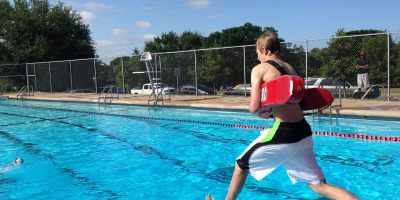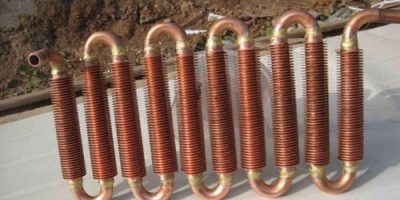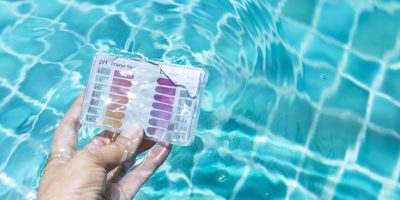Summer is around the corner and one of the most common and frustrating problems any pool owner will tell you about is trying to keep their pool from turning green when the weather gets hot. It happens to even the most diligent pool owners, and while a pain to deal with, it can be remedied and managed with the right knowledge and tools!
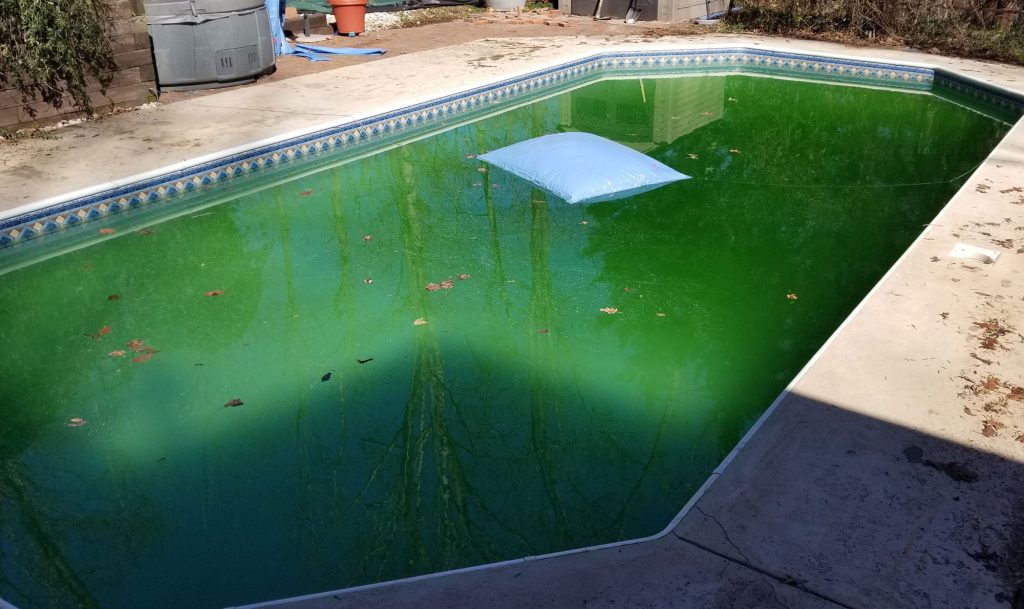
(source: troublefreepool.com)
Causes of Green Pool Water:
- Weather:
Hot weather doesn’t help your pool unfortunately. The temperature of pool water can affect its pH and the effectiveness of your chemicals and sanitizers. Outdoor pools in summer are often given higher doses of chemicals to help offset this effect, but sometimes it’s simply not enough. - Chemical Imbalance:
Whether you use chlorine or bromine, your pool can be caught with low levels and that’s where the problem begins. These sanitizers suppress the ability of algae and bacteria to thrive and propagate in your pool water, but they must be kept at the appropriate levels to do their job effectively. - Algae:
When sanitizer drops down below a certain level, and the pool has been in use, and it’s a hot summer day, you’ve got all the conditions for algae and bacteria to thrive. All it takes is a few spores and time and before you know it, your once lovely crystalline pool is a green swamp. - Organic Matter:
So how’d it get there in the first place? Usually when other organic matter transports it into your pool. This can be on leaves and debris that are blown in, on ourselves when we use the pool, and especially on any unfortunate small animals or critters that may get stuck and die in the water.
It’s not nice to talk about, but one of the most common reasons for sudden and fast growing algae-blooms is a mouse or lizard that drowned and began it’s decomposition in the pool. The bodies are usually sucked up by the vacuum or skimmer, so it’s very important to frequently check the skimmer and pump baskets.
How To Clarify Green Pool Water
Ok, so the pool is green, what now? How do you get it back to normal when it looks more like your local pond than your pool? Don’t panic! Following these steps you’ll be able to defeat all but the most stubborn algae-blooms.
The first thing you should always do when something is off with your pool is a water test! Kits can use liquid reagents, or just be dip sticks that give color readouts, but every pool owner should own one! It will save you many headaches and a lot of money down the road.
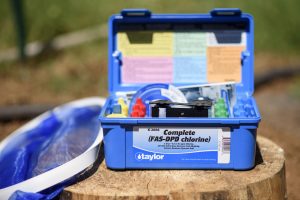
(source: troublefreepool.com)
Testing Chemicals
- pH range:
pH determines if water is acidic or basic. Pool water should range between 7.2 and 7.8 depending on location and water-source. When pool water is within this range, it is safest for use, as well as best suited for holding chemicals and sanitizers effectively.
Muriatic acid is usually used to bring pH down, and soda ash or sodium bicarbonate (baking soda) to raise it. Add either as needed and conduct further water tests to confirm a more balanced pH.
- Sanitizer Levels:
Whether you use chlorine or bromine in your pool, regular testing of their levels is essential to know when more must be added. Staying on top of this regularly can help you catch a bloom before it begins! Test several times a week in summer if possible to learn how quickly your sanitizer is depleting and make adjustments accordingly.
- Phosphates:
This is a complex topic that I will try to simplify as best I can: In short, algae eat phosphates, and when they are present in large quantities in a pool, can cause algae-blooms that are powerful enough to ignore sanitizers or even shock treatments.
Phosphate management is complex due to many factors including environment and water-source. If you test your water for phosphates and find levels outside of recommendations, consulting with a professional maintenance service should be considered.
Sanitize Your Water
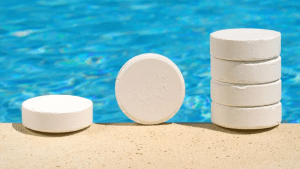
Chlorine:
When using chlorine as your sanitation method, effective levels range between 1-4ppm (part per million) of Free Chlorine (FC). When it decomposes, free chlorine breaks down into compounds called chloramines which is what gives pools that use it that particular odor. Unfortunately, chloramine does not provide sanitation, and instead is lighter than water and gasses off the surface.
Sunlight, and naturally-occurring nitrogen and ammonia break chlorine down into chloramine; bacteria and algae feed off these elements and thrive in warmer conditions as well, so on a hot day, a missed chlorine dose can turn a pool green very quickly, especially if it’s been in use!
Cyanuric acid is commonly used as an additive in chlorinated pools as it helps slow break-down. It’s often present in chlorine tablets used for sanitation.
Bromine:
Pools that use bromine as a sanitizer should have test readings between 3-5ppm. Bromine is preferred in indoor pools and spas because it is more vulnerable to UV radiation from the sun and is therefore ill-suited for outdoor installations. Its advantage however is that it is much more stable than chlorine and lasts longer before needing to be replenished.
Slightly more expensive than chlorine, bromine offers an alternative to sanitize indoor pools as well as spas. The reason these are preferred is because bromine is more susceptible to UV radiation from sunlight than chlorine and breaks-down easier making it much less effective in outdoor pools. However, when not exposed to sunlight, it lasts much longer than chlorine does.
Like chlorine, bromine breaks down into compounds called bromamines which, like chloramines, are not effective sanitizers. However, the additional advantage this offers over chlorine is that these bromamines do not gas off and can be reconverted into bromine with the application of non-chlorine shock treatment. While bromine costs more at the time of purchase, when it can be used, it saves money in the long run.
Shock Treatment:
Pool shock is a chemical composition that is added as a one-time solution to algae-blooms. It is a powerful combination of different chemicals and sanitizing agents. It’s meant to be used sparingly, not as a regular addition to pool chemicals like sanitizers, acid, or soda ash.
Whether it’s chlorine-based or not, addition of this compound will eradicate algae-blooms and other organic compounds present in the pool water. It is recommended to use these products following given instructions carefully as they can be caustic and dangerous if misused or stored improperly.
The process of shocking your pool should take between 12 to 24 hours. During this time make sure your filter is running to get the treatment spread throughout the entire system. The pool is not safe for use during this time as the water’s chemical compositions are very high. These levels will decrease after about a day of constant filtration.
Taking Care of Your Filter

(source: troublefreepool.com)
After adjusting the chemicals in your pool water it’s time to make sure the source of your algae isn’t coming from your filter. Over time, especially when the pool is in use during the hot months of the year, algae can build up in the filter grids latching on to the various bits of debris and filth that get stuck over time.
If your filter allows for it, a backwash can be a great way to mitigate algae build-up. Turn the system off, set your filter’s valve to the backwash setting then turn the system on for 15-30 seconds. This will purge a great deal of water out of the filter very quickly and is an effective way to help it do its job more efficiently between tear-downs.
Bi-annual tear-downs of a filter are highly recommended as they help mitigate algae build-up as well as lower system pressure along with other beneficial side-effects for the pool. If you plan on doing a tear-down yourself, please remember to shut down the system entirely and purge any remaining air or water from the filter before disassembly as it is under an enormous amount of pressure and can be dangerous otherwise.
Brushing Your Pool Surfaces
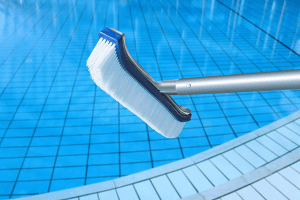
(source: amazon.com)
Once you’ve gotten your pool chemistry and filtration sorted, it’s time for some good old fashioned elbow grease. Algae loves to cling to the submerged surfaces of your pool, so you’ll have to brush it off. It can be very stubborn as well, so there are special metal-bristle brushes that can make the job easier, however these should never be used with pools made of certain materials! Fiber-glass pool liners will be shredded over time by these brushes and above-ground pools can be punctured by the very sharp bristles. Only use this type of brush if your pool is plaster or tile. For all others, nylon brushes should be perfectly safe.
Vacuuming and Clean-Up
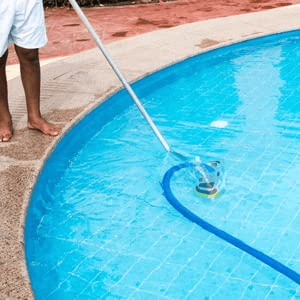
(source: amazon.com)
If you’ve done all of the above, I’m sure your pool looks even worse now! That’s OK! It’s all part of the process to get rid of it. All that algae that you brushed off the walls is now floating in the water, dying from the shock treatment and sanitizers you added, and then drifting to the bottom ready to be vacuumed up by you or your auto-cleaner.
If you want to help this process along, you could use a clarifying or flocculant agent to help bind it all together and make it easier for your filter to catch. Either way, you will have to wait for it all to settle.
Leave it overnight and by morning you’ll see a noticeable difference in the appearance of your pool!
If you have your own pole and vacuum-head, go ahead and give the pool a pass and marvel at how quickly it looks like its beautiful old self!
Conclusions
Of important note is that sometimes algae-blooms can be so aggressive that all of what I discussed above simply won’t be enough. In those extreme cases it’s not unwise to consult a professional maintenance service as they will have access to chemicals and equipment that is more powerful than what’s available on the consumer market. Many services will offer a one-time “restart” service to help you get your pool back to normal.
Clearing algae-blooms from pools can be a frustrating process that when resolved is very satisfying but when not, can cause quite a headache. Be patient with yourself and keep at it! Sometimes it may take several days as well as chemical applications to get a particularly bad bloom back under control. Doing additional backwashes or teardowns of your filter can also help to speed the process, especially after vacuuming up all the debris. Just make sure to keep testing the water, as that should tell you everything you need to know about what you should do next.
Good luck and happy swimming!







